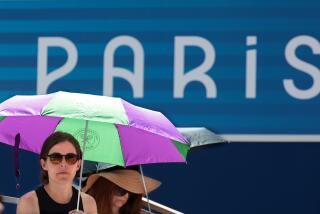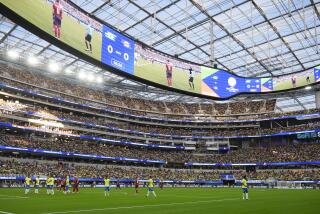WORLD CUP USA ’94 / THE FIRST ROUND : For Some, This Cup Is Too Hot to Handle : Weather: Heated discussions rage about temperatures and humidity; others coolly dismiss it as excuse-making.
DALLAS — We had to find something in common because while we’re talking about John Starks, they’re talking about John Harkes. While we’re talking roundball, they’re talking about a round ball.
With all these soccophiles rambling around the United States speaking in tongues, drastic measures had to be taken.
So, it seems, we’ve dusted off that old conversational icebreaker, the weather.
The sultry, sticky, steamy days of summer are upon us, and that’s practically all anyone wanted to discuss during the first week of World Cup ’94. The Lower 48 are sweltering like a Mississippi swamp, and everyone is thunderstruck.
Let’s put this as delicately and succinctly as possible: If it’s summer, it’s hot and humid. Those in Alaska need not reply.
Yet, the cacophony of complaints echoing across the land could drown out the cheers at the nine stadiums where they are showcasing international soccer’s quadrennial event.
It’s like complaining about the Winter Olympics being cold.
But because soccer is a worldwide passion, grumbling during World Cup tournaments is in fashion.
In 1986, it was Mexico’s altitude. The altitude and the heat and the smog, and the water and those two Moroccan army tanks that were escorting the team until Mexican officials put the kibosh on it.
Despite the oppressive conditions, 34 of 52 games began at noon to accommodate European television, similar to the situation in the United States, where most early-round matches are starting in the afternoon.
“Journalists predicted players would die (in Mexico),” recalled Guido Tognoni, a spokesman for FIFA, soccer’s international governing body.
They didn’t.
“Monterrey (Mexico) was one of the hottest places on Earth during the World Cup,” Andreas Herren of FIFA said.
In 1990 in Italy, it was the heat again. The heat and the hooligans and the train strikes. Yugoslavia and Argentina played a quarterfinal game in Florence in temperatures that reached 104 degrees but without the energy-sapping humidity much of the eastern United States experienced during the weekend.
Now, in the Cup’s U.S. debut, here’s what they are saying:
--From San Francisco, Alan Rothenberg, chairman-chief executive officer of World Cup ‘94: “So far, everything has been about as good as we hoped for, except for the awful heat everywhere except California.”
--From Chicago, goalkeeper Carlos Leonel Trucco of Bolivia, accustomed to playing in 12,000-foot-high La Paz: “I think these schedules were (designed) to kill players. They should change the game times.”
After Germany had defeated Bolivia, 1-0, in the Chicago opener last Friday, German forward Juergen Klinsmann said, “All along we have trained for the heat, but once you get out on the field it is different. To get a rhythm going under those brutal conditions was really difficult.”
--From Pontiac, Mich., U.S. Coach Bora Milutinovic, before his team played Switzerland in the Silverdome: “I hope it is 300 degrees and 2,000% humidity.”
--From Washington, Coach Miguel Mejia Baron of Mexico: “I would tell those gentlemen from FIFA to take their suits off and play soccer. If they could choose between midday and 7 in the evening, I am sure they would choose to play at 7 p.m.”
Tognoni, of Switzerland, accepted Baron’s challenge. He kicked a ball around the field in Dallas’ Cotton Bowl last weekend and reported that a slight breeze blows through, making conditions bearable.
--From Dallas, Bulgarian forward Velko Iotov, whose team opened training camp in Austin, Tex.: “It’s hard to breathe correctly.”
The Belgians were so obsessed with heat, they wore protective hair gel to reflect the sun during their game last week in Orlando against Morocco.
The Swiss and Irish complained officials were too rigid when it came to allowing water bottles on the field. Regulations allow bottles on the sidelines and near the goal.
Officials said teams know where to line the bottles so that most players can take a quick drink whenever the action is away from them.
“We encourage them to drink water,” Tognoni said.
Heated debates also were heard about using the conditions as justification for poor showings, as did Sweden in its 2-2 draw with Cameroon at the Rose Bowl.
“It’s a bit of an easy excuse for Sweden to say they were suffering from the sun,” said Joseph-Antoine Bell, Cameroon’s goalkeeper. “It’s not going to get any cooler. They better get used to it.”
The Swedes wilted on a typically hot San Gabriel Valley day, which left some fans wondering why they had selected cool San Diego as a training site to prepare for games in Pasadena.
And then there were those who complained that Brazil, which opened at Stanford Stadium, the coolest of the nine sites, had a big advantage because everyone knows what Rio is like in the summer.
“Who says that?” asked Carlos Alberto Parreira, Brazil’s coach. “Brazilian players will not be affected by the weather conditions? Brazilian players are not human? We have 11 players who play in Europe, not in Brazil, during the year. To give 100% effort in this weather, you’d have to be a robot.”
So far, the humans are doing fine. Officials said none of the players have suffered from heat-related complications.
The same could not be said for 106 fans in Orlando last weekend who were treated for mostly minor heat problems. In Chicago, 43 were treated for heat exhaustion and 13 were hospitalized last Friday, opening day.
“Everyone is sweating so much they don’t have to use the rest room,” a Chicago woman said.
Jim Knochel, chairman of internal medicine at Presbyterian Hospital of Dallas and one of the country’s foremost experts on heat exhaustion, said the conditions are dangerous only if athletes do not take proper precautions.
He said lack of acclimatization is the biggest factor, and most people need at least two weeks to become comfortable.
“I’ve been concerned for some weeks about these people coming to town from cooler climates and higher altitudes,” Knochel said.
But because soccer players are some of the world’s fittest athletes, he expects few problems from the heat. Knochel said the best precautions are drinking lots of water and generously salting foods to replenish elements lost through exercise.
“If you are urinating properly, that’s the best measure,” he said. “The kidneys are efficient. That tells you if your water and salt stores are replete.”
Knochel also said the athletes should spend time in the heat during days off, instead of staying in air-conditioned rooms.
“Their endocrine glands and kidneys will have a better chance to adapt,” he said. “They need all the help they can get.”
At least most do.
Perhaps Saudi Arabia was the only team wishing it were hotter. The Saudis opened the World Cup on a humid 86-degree day in Washington last Monday and goalkeeper Muhammad Al Daeyea actually donned long pants.
The rest of the Saudis played in shorts, though.
Times staff writers Helene Elliott, Emilio Garcia-Ruiz, Randy Harvey and Bill Plaschke, and special correspondent Martha Vargas-Seagle contributed to this story.






